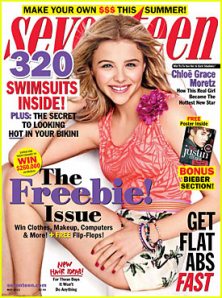The final outcome of this story will tell us if the editors of Seventeen Magazine listened to their readers. But the beginning of the story really tells the tale of what the future of reader influence and input could look like in the world of magazine publishing. That is because this is the story about what the publishing world looks like when creative readers try to influence the editorial direction of a favorite magazine.
Eighth grader and Seventeen reader Julia Bluhm was concerned about the use of photoshopped images of girls in the magazine. She and others felt that the images did not represent real teen girls and sent the wrong message about what young women should look like (Editor’s Note: This father of young women agrees). A blogger and member of the SPARK Movement, Julia set up a petition on line that quickly gained the attention of the Huffington Post and the UK’s Daily Mail. She also gained more than 50,000 signatures to her petition.
Julia then decided to make her point more personal and direct. She traveled to Manhattan and camped outside the headquarters of Seventeen where she and other supporters from around the country staged a mock photo shoot. Just some everyday American girls in street clothes being themselves.

Was the protest successful? Reports say that editor in chief Ann Shoket invited Julia up to her office to discuss her concerns. Seventeen later issued this statement:
“We’re proud of Julia for being so passionate about an issue – it’s exactly the kind of attitude we encourage in our readers… We believe that Julia left understanding that Seventeen celebrates girls for being their authentic selves, and that’s how we present them.”
So, no word on whether or not Seventeen will begin featuring “real girls” in their magazine or if editor Shoket used the power of her position to persuade Julia to reconsider her stance.
Probably not. The New York Times interviewed Julia and reported how she saw girls portrayed in the magazine:
“I look at the girls, and a lot of them, like, they don’t have freckles, or moles, anywhere on their bodies,” she said. “You can’t, like, see the pores in their face, they’re perfectly smooth. Their skin is shiny. They don’t have any tan lines or cuts and bruises or anything like that.”
One reason I like this story is because a gutsy teenage girl broke the teenage girl stereotype, took possession of an issue that meant something important to her, gathered some like minded people together, and did something creative about it. This is a story about readers who used social media to connect and state their concerns about a magazine they loved.
They could have stopped there. Our cynicism trains us to expect nothing more from today’s teenagers. But these kids beat expectations by taking that keyboard connection a step further and made it personal. They made it so personal their leader was invited to sit down with the magazine’s editor. How often does that happen? In this magazine professional’s mind, not nearly enough.
Will Seventeen feature an “no retouch” spread in the June issue? Will they show girls with freckles and splotches? Will the boys have 6-packs or look like or just look like regular teenaged boys?
It would be nice if they did. I won’t hold my breath but I am hopeful. Fourteen year old Julia Bluhm just showed them how powerful social media really is because good social media, good social action, good social theater is incredibly personal.
A well edited magazine is supposed to be personal too. You can’t photoshop that, by the way.

One Reply to “”